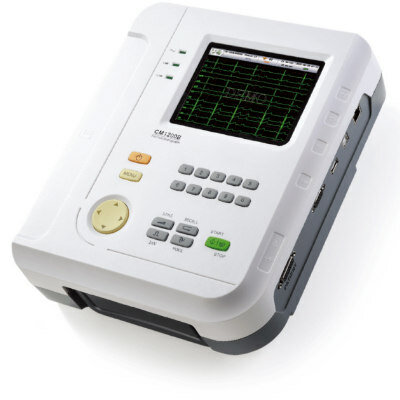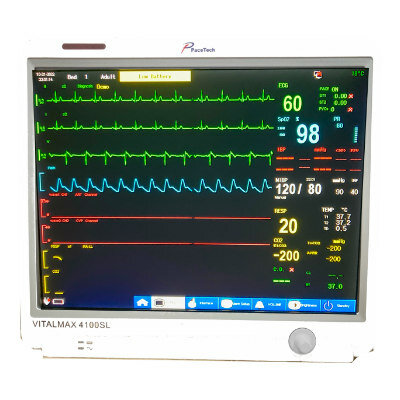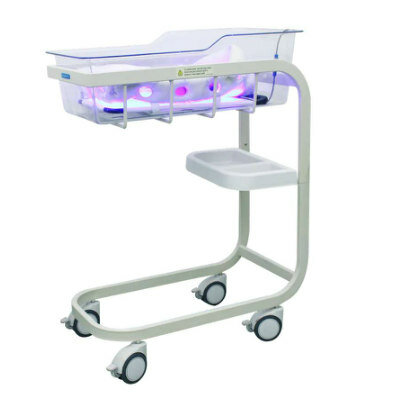Wireless Probe Detects Cancer Cells During Surgery
|
By HospiMedica International staff writers Posted on 23 Jun 2016 |

Image: The EPFL Beta probe (Photo courtesy of EPFL).
Novel wireless probes inserted into the surgical wound identify cancer cells and suspicious lymph nodes by emitting an auditory alarm that directs the surgeon.
Developed by researchers at Ecole Polytechnique Fédérale de Lausanne (EPFL; Switzerland), the Gamma and Beta probes are 20 centimeters long each and weigh around 100 grams, resembling a large pen. While the Gamma probe is an upgrade to similar devices already used, the Beta probe is a completely new device that is able to detect extremely small specimens of cancerous tissue by searching for positrons emitted by a tracer substance, which attaches to the cancer cells. Since positrons can only travel through a millimeter of tissue, when detected they pinpoint the tumor cells.
The Gamma probe does not directly detect cancer cells; instead, it finds a sentinel lymph node--the lymph node cancer cells reach before they make their way to the rest of the body--near the main tumor site. The lymph node can then be removed by the surgeons and used to stage the disease. If the sentinel lymph node is free of cancer cells, it means that the tumor has not spread. Both probes were tested at University Hospital Lausanne (CHUV; Switzerland), after earning the European CE mark in early 2015.
“The probe has a little window at one end that picks up the gamma rays or positrons given off by the substance injected into the patient,” said Edoardo Charbon, director of the Advanced Quantum Architecture Lab (AQUA) at EPFL. “A scintillator converts the energy of the rays into photons, which are then detected by a highly sensitive sensor.”
The positron is the antimatter counterpart of the electron; it has an electric charge of +1 e, a spin of ½, and has the same mass as an electron. When a low-energy positron collides with a low-energy electron, annihilation occurs, resulting in the production of two or more gamma ray photons. Positrons may be generated by positron emission radioactive decay (through weak interactions), or by pair production from a sufficiently energetic photon, which is interacting with an atom in a material.
Related Links:
Ecole Polytechnique Fédérale de Lausanne
University Hospital Lausanne
Developed by researchers at Ecole Polytechnique Fédérale de Lausanne (EPFL; Switzerland), the Gamma and Beta probes are 20 centimeters long each and weigh around 100 grams, resembling a large pen. While the Gamma probe is an upgrade to similar devices already used, the Beta probe is a completely new device that is able to detect extremely small specimens of cancerous tissue by searching for positrons emitted by a tracer substance, which attaches to the cancer cells. Since positrons can only travel through a millimeter of tissue, when detected they pinpoint the tumor cells.
The Gamma probe does not directly detect cancer cells; instead, it finds a sentinel lymph node--the lymph node cancer cells reach before they make their way to the rest of the body--near the main tumor site. The lymph node can then be removed by the surgeons and used to stage the disease. If the sentinel lymph node is free of cancer cells, it means that the tumor has not spread. Both probes were tested at University Hospital Lausanne (CHUV; Switzerland), after earning the European CE mark in early 2015.
“The probe has a little window at one end that picks up the gamma rays or positrons given off by the substance injected into the patient,” said Edoardo Charbon, director of the Advanced Quantum Architecture Lab (AQUA) at EPFL. “A scintillator converts the energy of the rays into photons, which are then detected by a highly sensitive sensor.”
The positron is the antimatter counterpart of the electron; it has an electric charge of +1 e, a spin of ½, and has the same mass as an electron. When a low-energy positron collides with a low-energy electron, annihilation occurs, resulting in the production of two or more gamma ray photons. Positrons may be generated by positron emission radioactive decay (through weak interactions), or by pair production from a sufficiently energetic photon, which is interacting with an atom in a material.
Related Links:
Ecole Polytechnique Fédérale de Lausanne
University Hospital Lausanne
Latest Surgical Techniques News
- Hydrogel-Based Miniaturized Electric Generators to Power Biomedical Devices
- Custom 3D-Printed Orthopedic Implants Transform Joint Replacement Surgery
- Wearable Technology Monitors and Analyzes Surgeons' Posture during Long Surgical Procedures
- Cutting-Edge Imaging Platform Detects Residual Breast Cancer Missed During Lumpectomy Surgery
- Computational Models Predict Heart Valve Leakage in Children
- Breakthrough Device Enables Clear and Real-Time Visual Guidance for Effective Cardiovascular Interventions
- World’s First Microscopic Probe to Revolutionize Early Cancer Diagnosis
- World’s Smallest Implantable Brain Stimulator Demonstrated in Human Patient

- Robotically Assisted Lung Transplants Could Soon Become a Reality
- AI to Provide Heart Transplant Surgeons with New Decision-Making Data
- New Surgical Tool Empowers Precision and Confidence in Operating Room
- Future Muscle-Powered Surgical Robots Could Perform Minimally Invasive Procedures inside Body
- Non-Invasive Technique Combines Cardiac CT with AI-Powered Blood Flow for Heart Bypass Surgery
- First-Of-Its-Kind Device Repairs Leaky Tricuspid Heart Valve
- New Signaling Method Enables Precise Localization of Miniature Robots and Surgical Instruments inside Body
- Novel Catheter System Enables Safer, More Cost-Effective Transseptal Procedures
Channels
Artificial Intelligence
view channel
AI-Powered Algorithm to Revolutionize Detection of Atrial Fibrillation
Atrial fibrillation (AFib), a condition characterized by an irregular and often rapid heart rate, is linked to increased risks of stroke and heart failure. This is because the irregular heartbeat in AFib... Read more
AI Diagnostic Tool Accurately Detects Valvular Disorders Often Missed by Doctors
Doctors generally use stethoscopes to listen for the characteristic lub-dub sounds made by heart valves opening and closing. They also listen for less prominent sounds that indicate problems with these valves.... Read moreCritical Care
view channel
Deep-Learning Model Predicts Arrhythmia 30 Minutes before Onset
Atrial fibrillation, the most common type of cardiac arrhythmia worldwide, affected approximately 59 million people in 2019. Characterized by an irregular and often rapid heart rate, atrial fibrillation... Read more
Breakthrough Technology Combines Detection and Treatment of Nerve-Related Disorders in Single Procedure
The peripheral nervous system (PNS) serves as the communication network that links the brain and spinal cord to every other part of the body. It consists of two parts: the somatic nervous system, which... Read morePatient Care
view channel
Surgical Capacity Optimization Solution Helps Hospitals Boost OR Utilization
An innovative solution has the capability to transform surgical capacity utilization by targeting the root cause of surgical block time inefficiencies. Fujitsu Limited’s (Tokyo, Japan) Surgical Capacity... Read more
Game-Changing Innovation in Surgical Instrument Sterilization Significantly Improves OR Throughput
A groundbreaking innovation enables hospitals to significantly improve instrument processing time and throughput in operating rooms (ORs) and sterile processing departments. Turbett Surgical, Inc.... Read more
Next Gen ICU Bed to Help Address Complex Critical Care Needs
As the critical care environment becomes increasingly demanding and complex due to evolving hospital needs, there is a pressing requirement for innovations that can facilitate patient recovery.... Read moreGroundbreaking AI-Powered UV-C Disinfection Technology Redefines Infection Control Landscape
Healthcare-associated infection (HCAI) is a widespread complication in healthcare management, posing a significant health risk due to its potential to increase patient morbidity and mortality, prolong... Read moreHealth IT
view channel
Machine Learning Model Improves Mortality Risk Prediction for Cardiac Surgery Patients
Machine learning algorithms have been deployed to create predictive models in various medical fields, with some demonstrating improved outcomes compared to their standard-of-care counterparts.... Read more
Strategic Collaboration to Develop and Integrate Generative AI into Healthcare
Top industry experts have underscored the immediate requirement for healthcare systems and hospitals to respond to severe cost and margin pressures. Close to half of U.S. hospitals ended 2022 in the red... Read more
AI-Enabled Operating Rooms Solution Helps Hospitals Maximize Utilization and Unlock Capacity
For healthcare organizations, optimizing operating room (OR) utilization during prime time hours is a complex challenge. Surgeons and clinics face difficulties in finding available slots for booking cases,... Read more
AI Predicts Pancreatic Cancer Three Years before Diagnosis from Patients’ Medical Records
Screening for common cancers like breast, cervix, and prostate cancer relies on relatively simple and highly effective techniques, such as mammograms, Pap smears, and blood tests. These methods have revolutionized... Read morePoint of Care
view channel
Critical Bleeding Management System to Help Hospitals Further Standardize Viscoelastic Testing
Surgical procedures are often accompanied by significant blood loss and the subsequent high likelihood of the need for allogeneic blood transfusions. These transfusions, while critical, are linked to various... Read more
Point of Care HIV Test Enables Early Infection Diagnosis for Infants
Early diagnosis and initiation of treatment are crucial for the survival of infants infected with HIV (human immunodeficiency virus). Without treatment, approximately 50% of infants who acquire HIV during... Read more
Whole Blood Rapid Test Aids Assessment of Concussion at Patient's Bedside
In the United States annually, approximately five million individuals seek emergency department care for traumatic brain injuries (TBIs), yet over half of those suspecting a concussion may never get it checked.... Read more
New Generation Glucose Hospital Meter System Ensures Accurate, Interference-Free and Safe Use
A new generation glucose hospital meter system now comes with several features that make hospital glucose testing easier and more secure while continuing to offer accuracy, freedom from interference, and... Read moreBusiness
view channel
Johnson & Johnson Acquires Cardiovascular Medical Device Company Shockwave Medical
Johnson & Johnson (New Brunswick, N.J., USA) and Shockwave Medical (Santa Clara, CA, USA) have entered into a definitive agreement under which Johnson & Johnson will acquire all of Shockwave’s... Read more
















